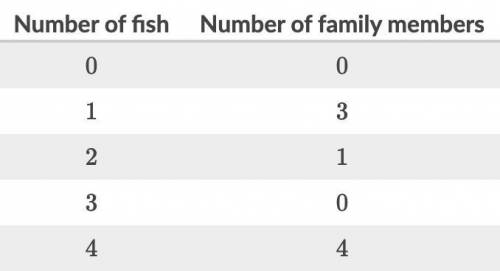
Mathematics, 12.08.2020 08:01, julionavedo21
The following frequency table shows the number of fish caught by each of Igor's family members. What was the maximum number of fish that a family member caught? _ fish


Answers: 1
Other questions on the subject: Mathematics


Mathematics, 22.06.2019 00:20, Jaymiegrimes22
Traffic on saturday, it took ms. torres 24 minutes to drive 20 miles from her home to her office. during friday's rush hour, it took 75 minutes to drive the same distance. a. what was ms. torres's average speed in miles per hour on saturday? b. what was her average speed in miles per hour on friday?
Answers: 1

Mathematics, 22.06.2019 01:00, jadensababe9151
On friday, there were x students at the baseball game. on monday, there were half as many students at the game as there were on friday. on wednesday, there were 32 fewer students at the game as there were on friday. which expression could represent the total number of tickets sold for all 3 games?
Answers: 2

Mathematics, 22.06.2019 03:00, kittenlover5031
In this problem, we explore the effect on the standard deviation of multiplying each data value in a data set by the same constant. consider the data set 14, 6, 8, 15, 15. (a) use the defining formula, the computation formula, or a calculator to compute s. (round your answer to one decimal place.) s = 4.28 (b) multiply each data value by 3 to obtain the new data set 42, 18, 24, 45, 45. compute s. (round your answer to one decimal place.) s = 12.83 (c) compare the results of parts (a) and (b). in general, how does the standard deviation change if each data value is multiplied by a constant c? multiplying each data value by the same constant c results in the standard deviation remaining the same. multiplying each data value by the same constant c results in the standard deviation being |c| times as large. multiplying each data value by the same constant c results in the standard deviation increasing by c units. multiplying each data value by the same constant c results in the standard deviation being |c| times smaller. (d) you recorded the weekly distances you bicycled in miles and computed the standard deviation to be s = 3.8 miles. your friend wants to know the standard deviation in kilometers. do you need to redo all the calculations? yes no given 1 mile ≠1.6 kilometers, what is the standard deviation in kilometers? (enter your answer to two decimal places.)
Answers: 1
Do you know the correct answer?
The following frequency table shows the number of fish caught by each of Igor's family members. What...
Questions in other subjects:

English, 13.04.2021 22:00






Mathematics, 13.04.2021 22:10

Mathematics, 13.04.2021 22:10


Mathematics, 13.04.2021 22:10






